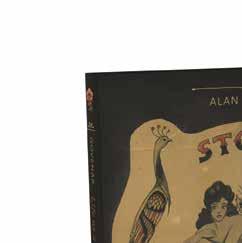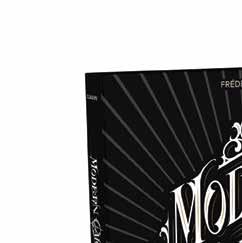
5 minute read
DESIGN THEORY

A simple question without a simple answer
Lisa S. Roberts




There are many books explaining the world of art, but practically none that introduce readers to the tenets of good design. This book fi lls that gap.
Reduces complex and sometimes abstract ideas to simple, clear language, illustrated by delightful cut-paper art
A fun gift book for creatives of all ages, written by a product designer, lecturer, and trustee at the Cooper Hewitt Smithsonian Design Museum and the Philadelphia Museum of Art
What do a folding bicycle, umbrella, toilet brush, and water bottle all have in common? ey are examples of good design—something we o en recognize but can’t express in words. is graphically delightful book is guaranteed to raise readers’ Design IQ by de ning the seven characteristics of good design. Each chapter describes one the seven characteristics of good design. Each chapter describes one characteristic, accompanied by ve product examples illustrated in characteristic, accompanied by ve product examples illustrated in cut-paper art. e colorful artwork and clear, simple language make cut-paper art. e colorful artwork and clear, simple language make complex and sometimes abstract ideas easy to understand, even for complex and sometimes abstract ideas easy to understand, even for those without a design background. Creatives of all ages will enjoy those without a design background. Creatives of all ages will enjoy learning about a wide range of smartly designed, everyday objects that learning about a wide range of smartly designed, everyday objects that work well, look beautiful, open our minds to new ideas, and stand the work well, look beautiful, open our minds to new ideas, and stand the test of time. test of time.
About the Author About the Author Philadelphia-based Lisa S. Roberts has been working in the design industry for Lisa S. Roberts has been working in the design industry for over 40 years as a product designer, author, host of a TV docuseries on design, and lecturer. She is a trustee at the Cooper Hewitt Smithsonian Design Museum and the Philadelphia Museum of Art. Author Location: Philadelphia, PA
Contents Good design Good design 1. Works Well 1. Works Well 2. Looks Good 3. Opens Our Mind to New Ideas 4. Improves Lives 5. Gives Us Joy 6. Is Innovative 7. Stands the Test of Time Featured products by designers Philippe Starck, James Dyson, Karim Rashid, Ettore Sottsass, Charles and Ray Eames, Irving Harper, Matti Walker, George Nelson, Isamu Noguchi, Ron Arad, and more
AVAILABLE APRIL
ISBN 978-0-7643-6405-1








Clues to Uptown New York’s Past
Frank Mastropolo
This timely book honors Uptown New York’s rich economic past, even as many of today’s long-established businesses are losing their leases
From Union Square to Harlem, the neighborhoods examined o er the most-telling clues to a long-gone way of life
Appealing to New Yorkers, historians, and urban archeologists, more than 100 photos and stories of faded business signs illuminate New York City’s past
Ghost signs hold the secrets of businesses and products that vanished decades ago. Clues to our jobs, schools, places of worship, cafés, and concert halls are hidden in their stories. New York City’s neighborhoods, from 14th Street to its northernmost point, contain scores of timeworn ads that have improbably survived for decades, and journalist and television producer Frank Mastropolo has captured and journalist and television producer Frank Mastropolo has captured their stories. O en, a storefront renovation yields the discovery of a their stories. O en, a storefront renovation yields the discovery of a sign that has been long obscured. Familiar brands like Studebaker and sign that has been long obscured. Familiar brands like Studebaker and Horn & Hardart’s Automat live on in these faded ads. Other moreHorn & Hardart’s Automat live on in these faded ads. Other morepuzzling signs refer to streetcars, snake oil cure-alls, and the forgotten puzzling signs refer to streetcars, snake oil cure-alls, and the forgotten aspects of city life. All are part of more than 100 photos and stories that aspects of city life. All are part of more than 100 photos and stories that sketch Manhattan’s economic and social fabric over the past century. sketch Manhattan’s economic and social fabric over the past century.
About the Author About the Author Frank Mastropolo writes a series about New York City’s ghost signs for writes a series about New York City’s ghost signs for New York Magazine’s ’s Bedford+Bowery blog. He is the author of Bedford+Bowery blog. He is the author of Ghost Signs: Clues Ghost Signs: Clues to Downtown New York’s Past and Fillmore East: The Venue That Changed Rock and Fillmore East: The Venue That Changed Rock Music Forever.Music Forever.
Author Location: New York, NY Author Location: New York, NY
Sampling of Neighborhoods • Meatpacking District • Meatpacking District • NoMad • NoMad • Union Square • Garment District • High Line • Gramercy Park • Chelsea • Flatiron District • Rose Hill • Tin Pan Alley • Fur District • Millinery District • Herald Square • Murray Hill • Murray Hill • Kipps Bay • Theater District • Hell’s Kitchen • Upper East Side • Upper West Side • Harlem
AVAILABLE MAY
ISBN 978-0-7643-6362-7
Illustrations: 125 color images Binding: hardcover BISAC: PHOTOGRAPHY / Subjects & Themes / Regional (see also TRAVEL / Pictorials)









